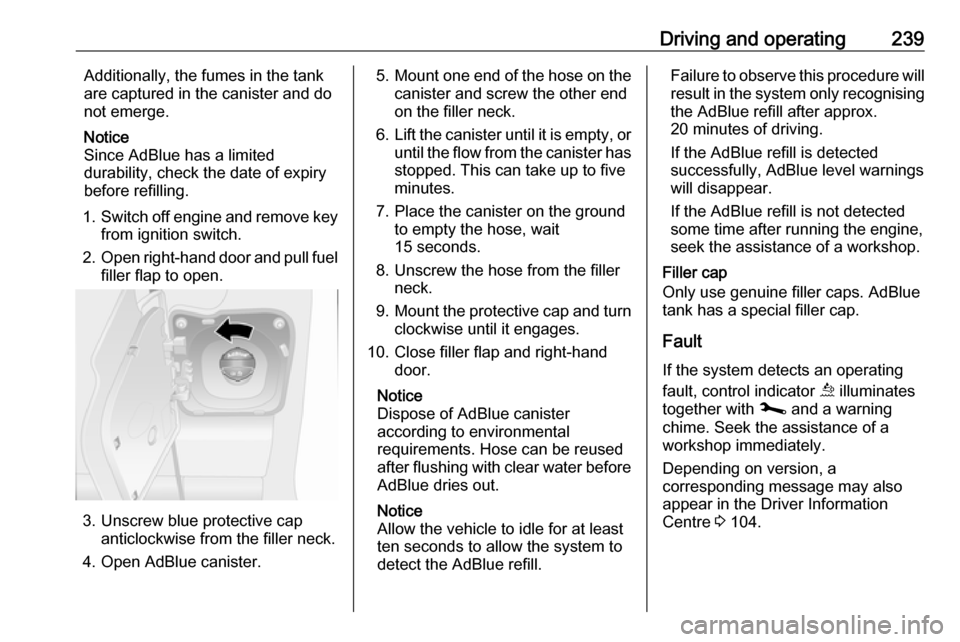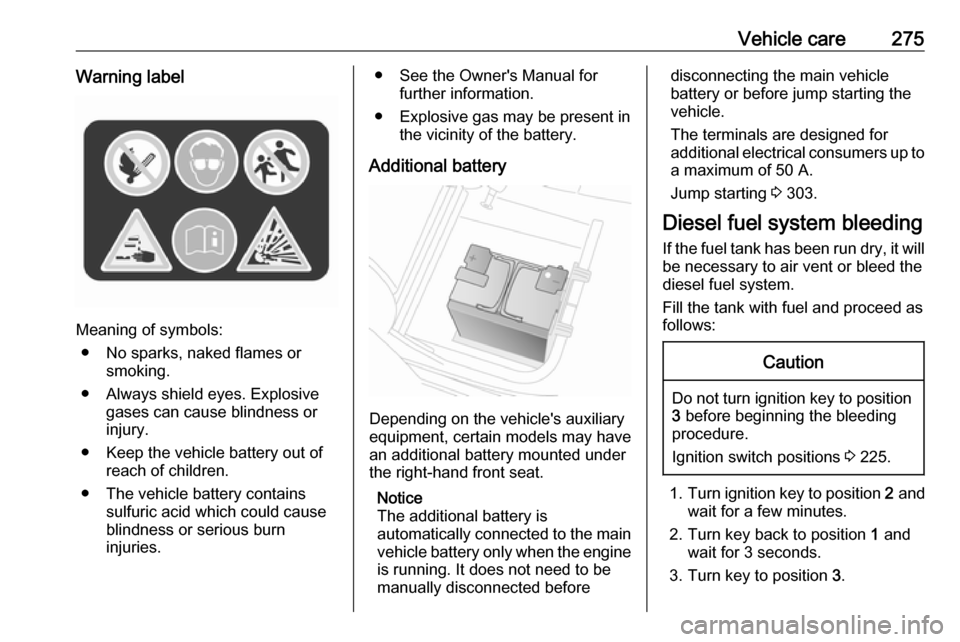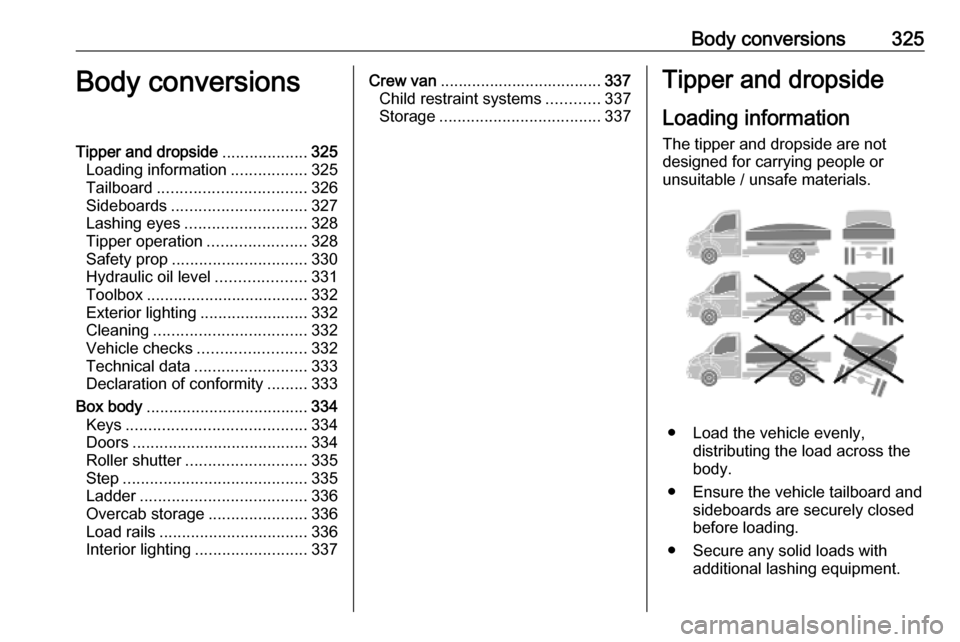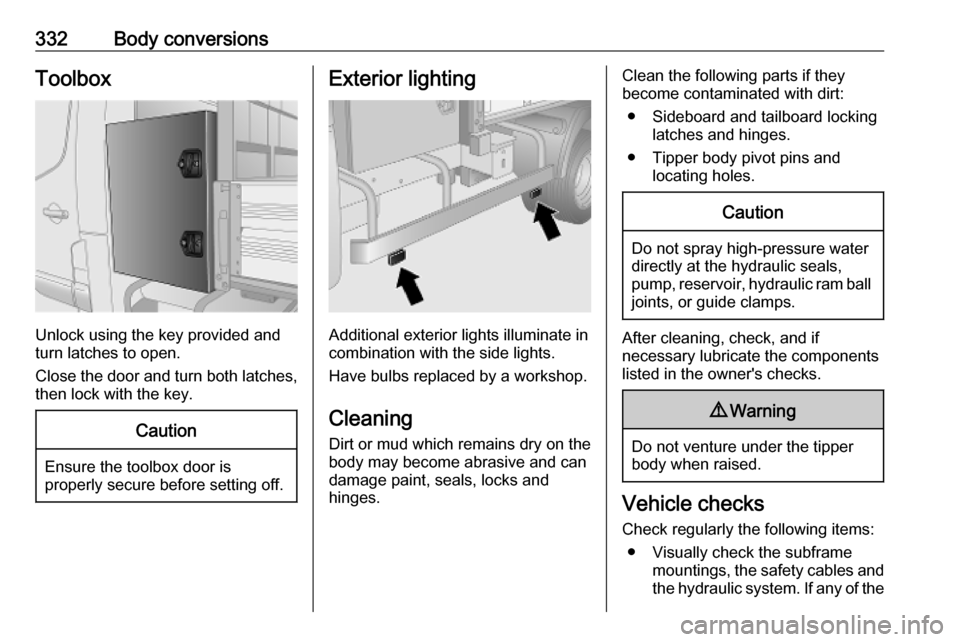key VAUXHALL MOVANO_B 2020 Repair Manual
[x] Cancel search | Manufacturer: VAUXHALL, Model Year: 2020, Model line: MOVANO_B, Model: VAUXHALL MOVANO_B 2020Pages: 351, PDF Size: 9.32 MB
Page 241 of 351

Driving and operating239Additionally, the fumes in the tank
are captured in the canister and do
not emerge.
Notice
Since AdBlue has a limited
durability, check the date of expiry
before refilling.
1. Switch off engine and remove key
from ignition switch.
2. Open right-hand door and pull fuel
filler flap to open.
3. Unscrew blue protective cap anticlockwise from the filler neck.
4. Open AdBlue canister.
5. Mount one end of the hose on the
canister and screw the other end
on the filler neck.
6. Lift the canister until it is empty, or
until the flow from the canister has stopped. This can take up to five
minutes.
7. Place the canister on the ground to empty the hose, wait
15 seconds.
8. Unscrew the hose from the filler neck.
9. Mount the protective cap and turn
clockwise until it engages.
10. Close filler flap and right-hand door.
Notice
Dispose of AdBlue canister
according to environmental
requirements. Hose can be reused
after flushing with clear water before
AdBlue dries out.
Notice
Allow the vehicle to idle for at least
ten seconds to allow the system to
detect the AdBlue refill.Failure to observe this procedure will
result in the system only recognising the AdBlue refill after approx.
20 minutes of driving.
If the AdBlue refill is detected
successfully, AdBlue level warnings
will disappear.
If the AdBlue refill is not detected
some time after running the engine,
seek the assistance of a workshop.
Filler cap
Only use genuine filler caps. AdBlue tank has a special filler cap.
Fault
If the system detects an operating
fault, control indicator ú illuminates
together with j and a warning
chime. Seek the assistance of a
workshop immediately.
Depending on version, a
corresponding message may also
appear in the Driver Information
Centre 3 104.
Page 265 of 351

Driving and operating2639Danger
Fuel is flammable and explosive.
No smoking. No naked flames or
sparks.
If you can smell fuel in your
vehicle, have the cause of this
remedied immediately by a
workshop.
A label with symbols at the fuel filler
flap is indicating the allowed fuel
types. In Europe the pump nozzles of the filling stations are marked with
these symbols. Refuel only the
allowed fuel type.
Caution
In case of misfuelling, do not
switch on ignition.
The fuel tank filler neck with bayonet
cap is located on the left front side of
the vehicle.
The fuel filler flap can only be opened
if the vehicle is unlocked and the door is opened. Open the fuel filler flap by
hand.
9 Danger
Vehicles with stop-start system:
The engine must be switched off
and the ignition key removed, to
avoid risk of engine being
restarted automatically by the
system.
Capacities 3 315.
Depending on vehicle, unlock fuel
filler cap using the key.
To open, turn the cap slowly
anticlockwise.
The fuel filler cap can be hung on the lower hook of the fuel filler flap.
Place the nozzle in straight position to
the filler neck and press with slight
force to insert.
After the automatic cut-off, the tank
can be topped up by operating the
pump nozzle a maximum of two more times.Caution
Wipe off any overflowing fuel
immediately.
To close, turn the fuel filler cap
clockwise.
Close the fuel filler flap.
Fuel filler cap Only use genuine fuel filler caps.Diesel-engined vehicles have special
fuel filler caps.
Page 277 of 351

Vehicle care275Warning label
Meaning of symbols:● No sparks, naked flames or smoking.
● Always shield eyes. Explosive gases can cause blindness or
injury.
● Keep the vehicle battery out of reach of children.
● The vehicle battery contains sulfuric acid which could cause
blindness or serious burn
injuries.
● See the Owner's Manual for further information.
● Explosive gas may be present in the vicinity of the battery.
Additional battery
Depending on the vehicle's auxiliary
equipment, certain models may have
an additional battery mounted under
the right-hand front seat.
Notice
The additional battery is
automatically connected to the main vehicle battery only when the engine
is running. It does not need to be
manually disconnected before
disconnecting the main vehicle
battery or before jump starting the vehicle.
The terminals are designed for
additional electrical consumers up to
a maximum of 50 A.
Jump starting 3 303.
Diesel fuel system bleeding If the fuel tank has been run dry, it will
be necessary to air vent or bleed the
diesel fuel system.
Fill the tank with fuel and proceed as
follows:Caution
Do not turn ignition key to position 3 before beginning the bleeding
procedure.
Ignition switch positions 3 225.
1. Turn ignition key to position 2 and
wait for a few minutes.
2. Turn key back to position 1 and
wait for 3 seconds.
3. Turn key to position 3.
Page 319 of 351

Customer information317Customer
informationCustomer information ................317
Declaration of conformity .........317
REACH .................................... 321
Registered trademarks ............321
Vehicle data recording and pri‐ vacy ........................................... 321
Event data recorders ...............321
Radio Frequency Identification (RFID) ..................................... 324Customer information
Declaration of conformity
Radio transmission systems
This vehicle has systems that
transmit and / or receive radio waves
subject to Directive 2014/53/EU. The
manufacturers of the systems listed
below declare conformity with
Directive 2014/53/EU. The full text of
the EU declaration of conformity for each system is available at the
following internet address:
www.opel.com/conformity.
Importer is
Opel / Vauxhall, Bahnhofsplatz,
65423 Ruesselsheim am Main,
Germany.
Radio remote control receiver Visteon Electronics
04 Rue Nelson Mandela, Zone
Industrielle Borj Cedria, 2055 Bir El
Bey, Tunisia
Operation frequency: 433 MHz
Maximum output: 10 mW ERPRadio remote control transmitter
Visteon Electronics
04 Rue Nelson Mandela, Zone
Industrielle Borj Cedria, 2055 Bir El
Bey, Tunisia
Operation frequency: 433 MHz
Maximum output: 10 mW ERP
Electronic key transmitter
ALPS ELECTRIC EUROPE GmbH
Ohmstrasse 4, 85716
Unterschleissheim, Germany
Operation frequency: 433 MHz
Maximum output: 10 mW ERP
Immobiliser
Visteon Electronics
04 Rue Nelson Mandela, Zone
Industrielle Borj Cedria, 2055 Bir El
Bey, Tunisia
Operation frequency: 125 kHz
Maximum output:
42 dBμA/m @ 10 m
Immobiliser
ALPS ELECTRIC EUROPE GmbH
Page 323 of 351

Customer information321REACH
Registration, Evaluation,
Authorisation and Restriction of
Chemicals (REACH) is a European
Union regulation adopted to improve
the protection of human health and
the environment from the risks that
can be posed by chemicals. Visit
www.opel.com/reach for further
information and for access to the
Article 33 communication.
Registered trademarksApple Inc.
Apple CarPlay™ is a trademark of Apple Inc.
App Store ®
and iTunes Store ®
are
registered trademarks of Apple Inc.
iPhone ®
, iPod ®
, iPod touch ®
, iPod
nano ®
, iPad ®
and Siri ®
are registered
trademarks of Apple Inc.Bluetooth SIG, Inc.
Bluetooth ®
is a registered trademark
of Bluetooth SIG, Inc.DivX, LLC
DivX ®
and DivX Certified ®
are
registered trademarks of DivX, LLC.EnGIS Technologies, Inc.
BringGo ®
is a registered trademark of
EnGIS Technologies, Inc.Google Inc.
Android™ and Google Play™ Store
are trademarks of Google Inc.Stitcher Inc.
Stitcher™ is a trademark of Stitcher,
Inc.Verband der Automobilindustrie e.V.
AdBlue ®
is a registered trademark of
the VDA.Vehicle data recording
and privacy
Event data recorders
Electronic control units are installed in
your vehicle. Control units process
data which is received by vehicle
sensors, for example, or which they
generate themselves or exchange
amongst themselves. Some control
units are necessary for the safe
functioning of your vehicle, others
assist you while you drive (driver
assistance systems), while others
provide comfort or infotainment
functions.
The following contains general
information about data processing in
the vehicle. You will find additional
information as to which specific data
is uploaded, stored and passed on to third parties and for what purpose in
your vehicle under the key word Data Protection closely linked to the
references for the affected functional
characteristics in the relevant owner's
manual or in the general terms of
sale. These are also available online.
Page 324 of 351

322Customer informationOperating data in the vehicleControl units process data for
operation of the vehicle.
This data includes, e.g.: ● vehicle status information (e.g. speed, movement delay, lateral
acceleration, wheel rotation rate, "seat belts fastened" display)
● ambient conditions (e.g. temperature, rain sensor,
distance sensor)
As a rule such data is transient, not
stored for longer than an operational
cycle, and only processed on board the vehicle itself. Control units often
include data storage (including the
vehicle key). This is used to allow
information to be documented
temporarily or permanently on vehicle
condition, component stress,
maintenance requirements and
technical events and errors.Depending on technical equipment
level, the data stored is as follows:
● system component operating states (e.g. fill level, tyre
pressure, battery status)
● faults and defects in important system components (e.g. lights,
brakes)
● system reactions in special driving situations (e.g. triggering
of an airbag, actuation of the
stability control systems)
● information on events damaging the vehicle
● for electric vehicles the amount of
charge in the high-voltage
battery, estimated range
In special cases (e.g. if the vehicle
has detected a malfunction), it may be
necessary to save data that would
otherwise just be volatile.
When you use services (e.g. repairs,
maintenance), the operating data
saved can be read together with the
vehicle identification number and
used when necessary. Staff working
for the service network ( e.g. garages,
manufacturers) or third parties (e.g.breakdown services) can read the
data from the vehicle. The same
applies to warranty work and quality
assurance measures.
Data is generally read via the OBD
(On-Board Diagnostics) port
prescribed by law in the vehicle. The operating data which is read out,
documents the technical condition of
the vehicle or individual components
and assists with fault diagnosis,
compliance with warranty obligations
and quality improvement. This data,
in particular information on
component stress, technical events,
operator errors and other faults, is
transmitted to the manufacturer
where appropriate, together with the
vehicle identification number. The
manufacturer is also subject to
product liability. The manufacturer
potentially also uses operating data
from vehicles for product recalls. This
data can also be used to check
customer warranty and guarantee
claims.
Fault memories in the vehicle can be
reset by a service company when
carrying out servicing or repairs or at
your request.
Page 327 of 351

Body conversions325Body conversionsTipper and dropside...................325
Loading information .................325
Tailboard ................................. 326
Sideboards .............................. 327
Lashing eyes ........................... 328
Tipper operation ......................328
Safety prop .............................. 330
Hydraulic oil level ....................331
Toolbox .................................... 332
Exterior lighting ........................332
Cleaning .................................. 332
Vehicle checks ........................ 332
Technical data ......................... 333
Declaration of conformity .........333
Box body .................................... 334
Keys ........................................ 334
Doors ....................................... 334
Roller shutter ........................... 335
Step ......................................... 335
Ladder ..................................... 336
Overcab storage ......................336
Load rails ................................. 336
Interior lighting ......................... 337Crew van.................................... 337
Child restraint systems ............337
Storage .................................... 337Tipper and dropside
Loading information The tipper and dropside are not
designed for carrying people or
unsuitable / unsafe materials.
● Load the vehicle evenly, distributing the load across the
body.
● Ensure the vehicle tailboard and sideboards are securely closed
before loading.
● Secure any solid loads with additional lashing equipment.
Page 334 of 351

332Body conversionsToolbox
Unlock using the key provided and
turn latches to open.
Close the door and turn both latches,
then lock with the key.
Caution
Ensure the toolbox door is
properly secure before setting off.
Exterior lighting
Additional exterior lights illuminate in
combination with the side lights.
Have bulbs replaced by a workshop.
Cleaning Dirt or mud which remains dry on thebody may become abrasive and can
damage paint, seals, locks and
hinges.
Clean the following parts if they
become contaminated with dirt:
● Sideboard and tailboard locking latches and hinges.
● Tipper body pivot pins and locating holes.Caution
Do not spray high-pressure water
directly at the hydraulic seals,
pump, reservoir, hydraulic ram ball
joints, or guide clamps.
After cleaning, check, and if
necessary lubricate the components
listed in the owner's checks.
9 Warning
Do not venture under the tipper
body when raised.
Vehicle checks
Check regularly the following items: ● Visually check the subframe mountings, the safety cables andthe hydraulic system. If any of the
Page 336 of 351

334Body conversionsBox body
Keys
The radio remote control only
operates the front door locks.
Additional keys are provided for the
load compartment door locks.
Doors Side door
Unlock by turning the key under cover( 1 ) in the side door lock. Press button
( 2 ) and fully extend door handle ( 3).
Pull the door handle to open door.
When closing, with the door handle
fully extended; push the door shut.
Push the handle back into the recess
and lock with the key to secure.
Rear doors
Opening
Unlock by turning the key under cover( 1 ) in the rear door lock. Press button
( 2 ) and fully extend door handle ( 3).
Pull the door handle to open door.
The left-hand rear door is opened by
lifting the interior catch.
Page 337 of 351

Body conversions335When opening the doors to 270°, the
doors are retained in the fully open
position by securing the catches on
the body side.
Closing
Release the catches from the body
side and always close the left-hand
rear door first.
When closing, with the door handle
fully extended; push the door shut.
Push the handle back into the recess
and lock with the key to secure.
Roller shutterOpeningUnlock by turning the key in the rear
door lock ( 1).
Turn latch ( 2) to release lever.
Lift lever ( 3) fully until the safety catch
is engaged.
Closing
Pull the roller shutter down using the
strap. Release catch ( 2) and lift lever
( 1 ) until it engages. Turn latch to
secure lever and lock using the key.
Step
To lower the step, pull the step out
from beneath the vehicle body and swing it down.
To stow the step, swing up into the
horizontal position and push into the
recess under the vehicle body.